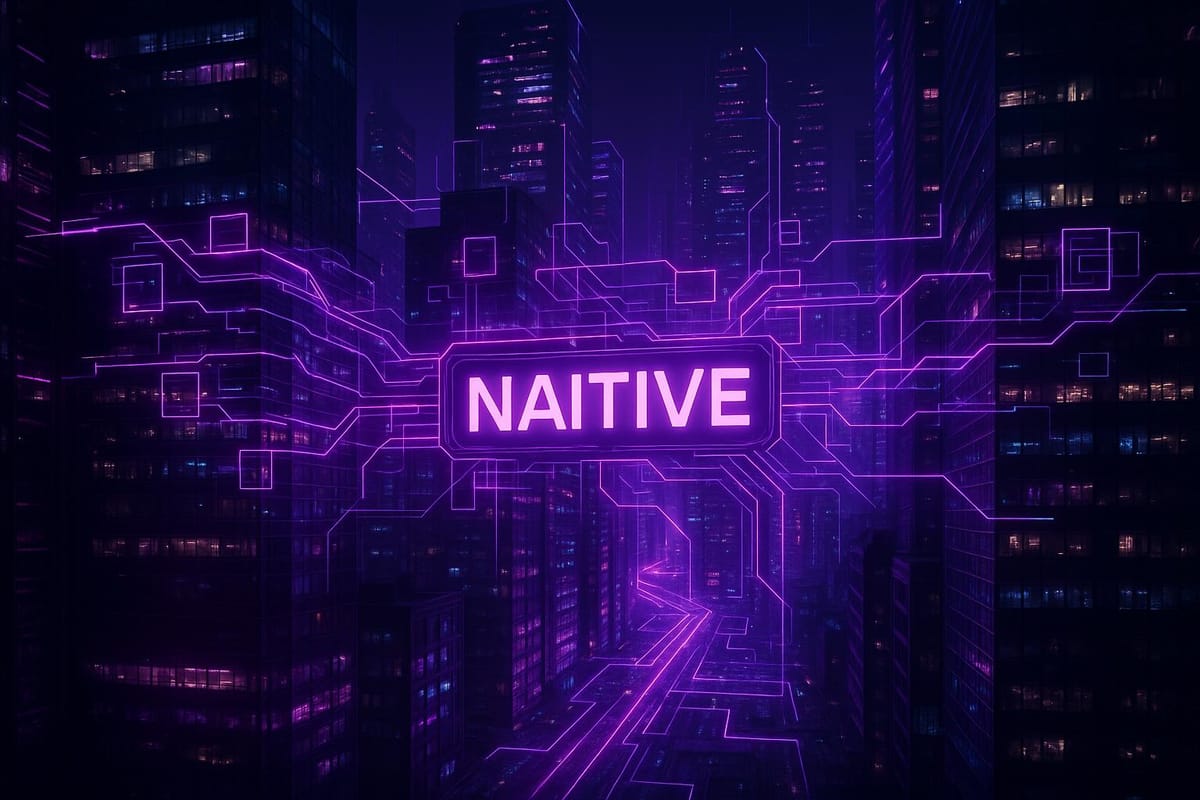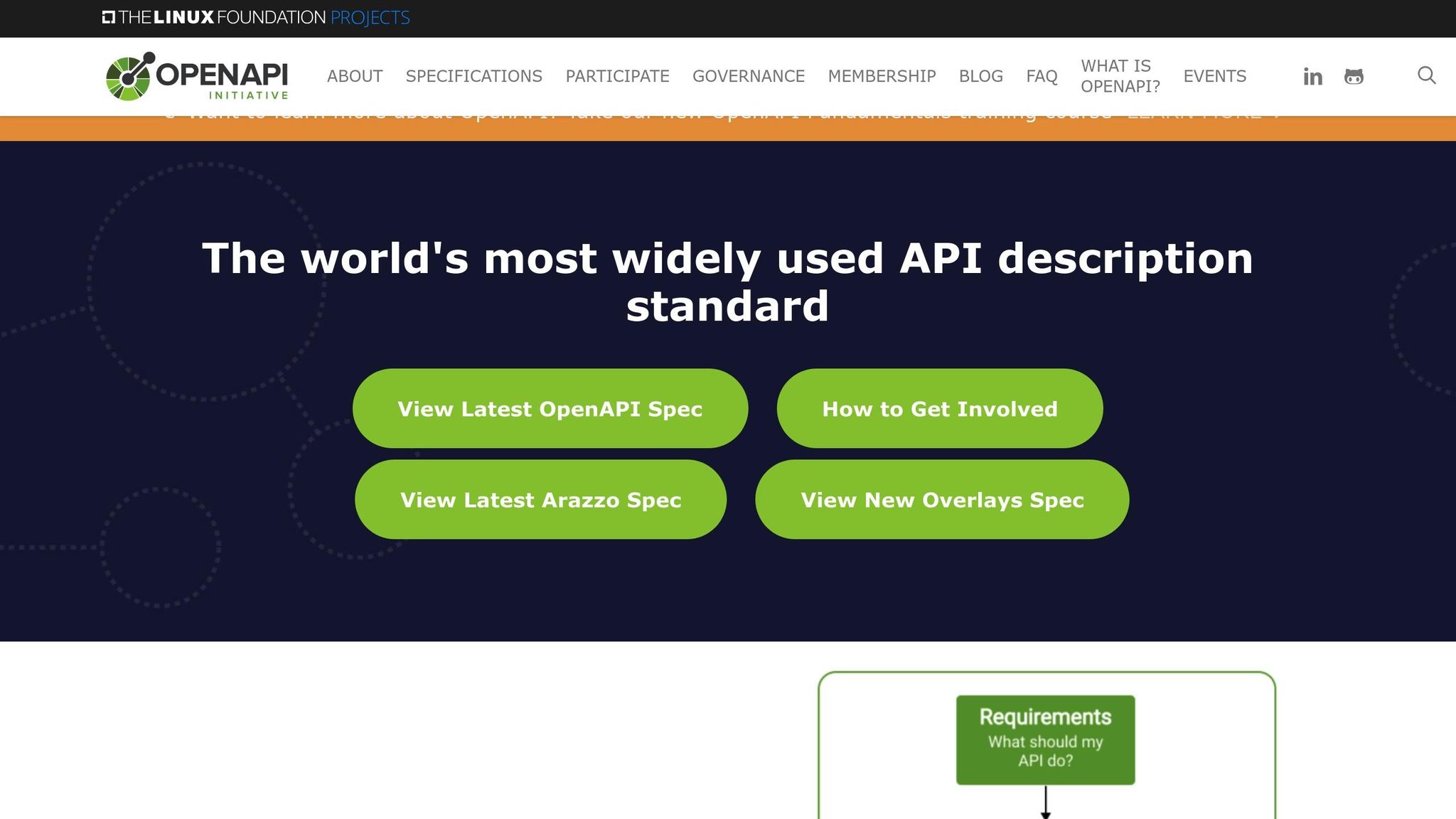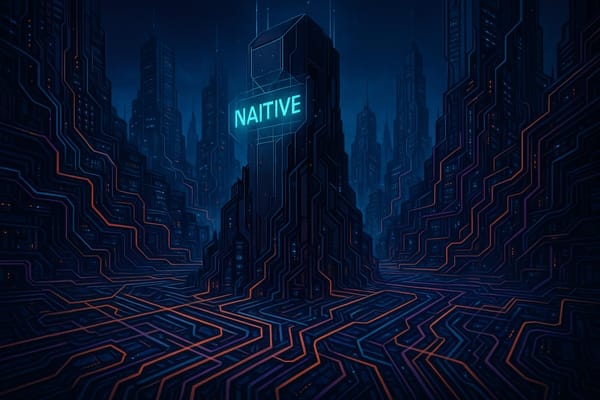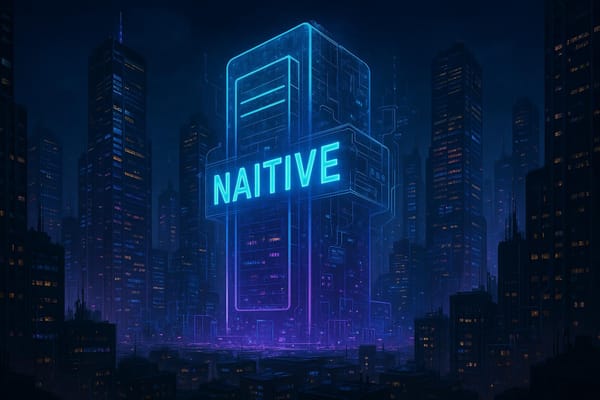How to Build APIs for AI Agent Interoperability
Learn how to design APIs for AI agents to ensure seamless communication, scalability, and security in multi-agent systems.

APIs are the backbone of AI agent communication. They allow AI systems to share data and work together across different platforms. This article breaks down how to design APIs that enable smooth interactions between AI agents, focusing on key protocols, efficient architectures, and practical implementation strategies.
Key Takeaways:
- Interoperability Basics: AI agents need shared protocols (like JSON-based messaging) to collaborate without custom integrations.
- Architectural Choices: Centralized (hub-and-spoke) models are easier to manage but risk single points of failure. Decentralized (mesh) setups are more resilient but require advanced coordination.
- Protocols to Know: MCP, ACP, and A2A enable dynamic communication between agents, while OpenAPI and Swagger streamline documentation and integration.
- Challenges: Legacy systems, mismatched protocols, and scaling issues can hinder interoperability. Security is also critical when agents access sensitive data.
- Optimization Tips: Use caching, event-driven models, and microservices for better performance. Kubernetes simplifies scaling and resource management.
Bottom Line: Building effective APIs requires thoughtful design, the right protocols, and a focus on scalability and security. With these tools, businesses can create AI ecosystems that improve workflows and cut costs.
Unlocking AI Interoperability: A Deep Dive into the Model Context Protocol
Core Architecture Patterns for Interoperability
The way you design your API architecture determines how agents interact - ranging from straightforward centralized setups to intricate distributed systems. These patterns lay the groundwork for creating effective API strategies that align with your goals.
Hub-and-Spoke vs. Mesh Architectures
Hub-and-spoke architectures rely on a central hub to manage all communication within the AI agent network. This setup offers a single point of control, making it easier to oversee operations, enforce security, and maintain governance. With all messages passing through one hub, monitoring becomes streamlined.
However, this centralized design has its downsides. A failure in the central hub can disrupt all communication, creating a potential bottleneck. This makes hub-and-spoke architectures an excellent choice for smaller systems or regulated industries where control and oversight outweigh the need for scalability.
On the other hand, mesh architectures allow agents to communicate directly with one another, bypassing any central hub. This decentralized structure enhances both resilience and flexibility. If one agent fails, the others continue to function as usual, as there's no single point of failure.
That said, mesh systems come with their own set of challenges. They require sophisticated coordination, including mechanisms for agent discovery, protocol negotiation, and independent security management. These features make mesh architectures a better fit for large-scale distributed systems, autonomous vehicle fleets, or global research platforms where direct communication and fault tolerance are critical.
| Architecture | Best For | Key Advantage | Main Challenge |
|---|---|---|---|
| Hub-and-Spoke | Small/medium systems, regulated industries | Centralized control and monitoring | Risk of bottlenecks and single points of failure |
| Mesh | Large-scale, distributed, dynamic systems | High flexibility and resilience | Complex coordination and discovery |
Event-Driven and Microservices Approaches
Beyond structural designs, dynamic communication models like event-driven architectures and microservices further improve interoperability.
Event-driven architectures eliminate the need for constant polling. Instead of agents frequently checking for updates, they respond to events in real-time. This approach reduces system overhead and enables low-latency communication. For example, when an agent completes a task or encounters a specific condition, it publishes an event that other agents can act on immediately. This creates responsive workflows, improving both efficiency and resource usage in multi-agent setups.
Microservices architecture takes modularity to the next level by treating each agent as an independent service. This allows you to deploy, update, or scale individual agents without disrupting the entire system. You can innovate quickly by upgrading specific components while ensuring overall stability.
When combined, event-driven and microservices architectures create dynamic, scalable systems. Agents operate independently but coordinate through events, enabling workflows that adapt to changing conditions. This approach supports systems that run continuously, handle complex tasks, and integrate seamlessly into existing enterprise processes.
Organizations adopting these patterns often experience better responsiveness and operational efficiency. The ability to scale agents independently while maintaining loose coupling between services leads to more adaptable and robust AI ecosystems.
Container Management for Multi-Agent Systems
Managing multi-agent systems can be daunting, but container orchestration platforms like Kubernetes make it easier. Kubernetes automates key processes like deployment, scaling, and resource allocation, ensuring efficient operations even as systems grow in complexity.
One of its standout features is self-healing. Kubernetes automatically restarts failed agents and performs rolling updates without causing downtime. This ensures reliable communication between agents and keeps your APIs accessible for collaboration.
Resource allocation is another critical factor in multi-agent systems. Different agents often require varying levels of computational power. Kubernetes dynamically assigns resources like CPU, memory, and network capacity to optimize performance across the entire system. It also supports horizontal scaling, adding or removing agent instances based on workload demands.
Security and network segmentation are equally important. Kubernetes offers tools to isolate agent communications, manage access controls, and protect sensitive information. These measures ensure agents can communicate securely while maintaining proper boundaries.
Additional features like load balancing, service discovery, and automated failover are crucial for maintaining system reliability. In real-world scenarios, these capabilities have reduced costs by 67% and boosted efficiency by 103%. By optimizing container management, you can ensure your APIs remain scalable, secure, and ready to support seamless agent interoperability.
For businesses aiming to adopt these advanced patterns, NAITIVE AI Consulting Agency offers expert guidance. They specialize in designing and managing AI solutions, helping organizations implement scalable, secure, and efficient agent ecosystems tailored to their needs.
Protocols and Tools for API Development
Choosing the right protocols is a critical step in ensuring smooth communication between AI agents. The options range from well-established standards to newer protocols designed specifically for agent interoperability. By understanding these tools, you can create systems that are both reliable and scalable, tailored to your specific needs.
Key Communication Protocols for AI Agents
Model Context Protocol (MCP) is a cutting-edge standard for agent communication. It allows agents to share and understand context dynamically, which makes integrating APIs much easier. With MCP, agents can automatically discover available endpoints and their requirements, eliminating the need for manual setup. Major players like Google Cloud and AWS have already incorporated MCP into their enterprise systems, highlighting its growing importance.
Agent Communication Protocol (ACP) provides a universal messaging format based on JSON, enabling agents to exchange structured messages without being tied to a specific framework. This shared messaging layer allows seamless communication between agents built on different platforms. For instance, IBM demonstrated how ACP enabled agents from frameworks like BeeAI and CrewAI to collaborate in real-time on tasks like research and content creation.
FIPA Agent Communication Language (ACL) is a well-established, vendor-neutral protocol developed by the Foundation for Intelligent Physical Agents. It defines message structures and interaction patterns, making it a reliable choice for enabling communication between diverse agents. While it may be more complex than newer protocols, FIPA ACL has proven its reliability in academic and research settings.
Agent2Agent Protocol (A2A) is a newer protocol designed for direct communication between agents. It supports multi-agent, cross-domain interactions and is backed by open-source frameworks like Strands Agents. With adoption by major cloud providers, A2A is ideal for organizations looking to build large-scale, cross-domain agent systems.
For real-time communication, WebSocket offers low-latency, two-way communication, making it perfect for scenarios requiring immediate responses. Meanwhile, MQTT is a lightweight protocol that excels in distributed systems, especially in IoT-enabled environments.
Using OpenAPI and Swagger for API Development

In addition to choosing the right protocols, thorough API documentation is essential for seamless agent integration. Tools like OpenAPI and Swagger simplify this process by creating self-describing, machine-readable API documentation. This approach enables automated service discovery and integration, so agents can understand endpoints, input/output requirements, and authentication protocols without manual effort.
One of the standout features of Swagger is its ability to generate interactive documentation automatically from OpenAPI specifications. This makes it easier for both developers and agents to test endpoints and understand request/response formats right away.
By defining an OpenAPI specification for an agent's REST API - covering tasks like data retrieval or action execution - you can allow other agents to consume the specification and configure their integration automatically. This eliminates the need for custom connectors and simplifies validation and testing, leading to more reliable systems.
Protocol and Framework Comparison
Selecting the right protocol depends on factors like security, scalability, and ease of implementation. The table below compares some of the most commonly used protocols and tools:
| Protocol | Security Features | Scalability | Ease of Adoption | Best Use Case |
|---|---|---|---|---|
| MCP | Enterprise authentication | High | Moderate | LLM and autonomous agent API integration |
| ACP | JSON-based messaging with metadata | High | High | Multi-framework agent collaboration |
| A2A | Enterprise-grade security | High | Emerging | Cross-domain, production-scale systems |
| FIPA ACL | Message encryption and authentication | Moderate | Moderate | Vendor-neutral agent communications |
| OpenAPI/Swagger | Authentication and authorization | High | Very high | API documentation and service discovery |
| WebSocket | Standard web security | High | High | Real-time agent communication |
| MQTT | Lightweight security | Very high | High | IoT-enabled and distributed agent networks |
Security is a key consideration, with protocols like MCP and ACP offering robust features for modern agent systems. Others, like MQTT and WebSocket, may require additional security enhancements. Scalability and implementation complexity also play a role in determining the best protocol for your needs.
These protocols and tools form the backbone of the API development process, setting the stage for creating efficient, interconnected agent ecosystems. For expert advice on designing multi-agent systems and API-driven automation, reach out to NAITIVE AI Consulting Agency.
Step-by-Step API Building Guide
This guide lays out a detailed approach to developing APIs that enable seamless interactions between AI agents. By following these steps, you can create APIs that are not only functional but also capable of meeting the demands of multi-agent systems. Success in this process requires careful planning, smart design choices, and consistent optimization.
API Design Best Practices
Start with clear API requirements and use OpenAPI specifications. OpenAPI helps you create machine-readable endpoints that agents can easily discover and use. This is crucial for enabling autonomous integrations.
Adopt robust API versioning. Use semantic versioning (e.g., v1.0, v1.1) and include the version in the URL or HTTP headers. This ensures backward compatibility, so existing agents can continue to function even when updates or changes are introduced.
Stick to consistent data formats. JSON is the preferred format for agent communication. Structure your API responses consistently and include standardized error codes with clear messages. For instance, use HTTP 429 for rate limits and include a "Retry-After" header to help agents manage their request pacing.
Develop a strong error-handling system. Provide agents with clear, actionable error responses. Use standard HTTP status codes like 400 for bad requests, 401 for authentication issues, and 500 for server errors. Pair these codes with detailed error messages to help agents retry failed requests or escalate problems as needed.
Secure your APIs with advanced authentication methods. Implement OAuth 2.0, JWT tokens, or API keys, and include role-based access controls to ensure secure and controlled interactions.
Once your API design is solid, you can focus on adapting older systems to work seamlessly with agents.
Converting Legacy APIs for Agent Compatibility
Evaluate your existing REST APIs. Legacy APIs often lack the structured responses and documentation agents rely on. Begin by auditing your current endpoints to identify the ones that provide essential functionality for agents.
Use protocol bridges and adapters to modernize responses. Instead of rebuilding legacy APIs, create middleware that translates their responses into standardized formats. These adapters can add metadata, reformat responses, and turn legacy endpoints into event-driven interfaces that agents can easily use.
Generate OpenAPI documentation automatically. Tools like Swagger can help you create detailed documentation, including parameters, examples, and authentication details. Swagger’s interactive features also make testing and validating the conversion process easier.
Migrate gradually. Start by updating the most critical endpoints and run hybrid systems to allow for testing and fine-tuning.
Add event-driven features to legacy systems. Integrate webhooks or message queues to notify agents about data changes in real time.
After updating your APIs, the next step is ensuring they perform well and can scale effectively.
API Performance and Scaling Optimization
Once your APIs are ready, focus on optimizing their performance and scalability to handle high demand.
Use caching solutions like Redis. Tailor cache TTLs (time-to-live) based on how often data changes. For example, user preferences might be cached for hours, while real-time sensor data might only be cached for seconds.
Design with asynchronous processing in mind. Implement message queues like RabbitMQ or Apache Kafka to manage large volumes of requests. This allows you to send immediate acknowledgments with tracking IDs, enabling agents to check the status of their requests later.
Offer bulk endpoints. Instead of requiring agents to make multiple small API calls, provide bulk endpoints that can handle several related requests at once. This reduces network overhead and improves efficiency.
Monitor usage patterns and scale dynamically. Use monitoring tools to track API response times, error rates, and usage trends. This data helps identify bottlenecks and informs scaling decisions. Platforms like Kubernetes are excellent for managing distributed systems, as they can automatically scale API instances based on demand.
Implement thoughtful rate limiting. While rate limiting protects your system from overload, overly strict limits can hinder agent performance. Use tiered rate limits based on agent types and priorities - for example, critical system agents might have higher limits than experimental ones. Include rate limit details in API responses so agents can adjust their request rates accordingly.
Enterprise Integration and Future Trends
Deploying AI systems in enterprise environments requires careful planning and strategic integration. These environments come with unique challenges that demand thoughtful approaches and an eye on emerging trends in the industry.
Gradual Implementation of Interoperability Standards
Start with small-scale pilot projects. Begin by integrating AI into non-critical workflows, like customer support chatbots or document processing. This allows you to demonstrate the value of the technology without jeopardizing essential operations.
Evaluate current workflows to pinpoint integration opportunities. Take a close look at how your systems currently interact. Identify areas where agent APIs can deliver the most value while requiring minimal disruption to your existing infrastructure.
Form cross-functional teams early. Include members from IT, security, and relevant business units to align technical decisions with business goals. These teams can also help identify potential roadblocks and streamline the integration process.
Use Kubernetes for modular integration. Kubernetes enables you to update or replace system components independently, minimizing risks during rollouts. This setup allows you to test new agent integrations alongside existing systems without causing disruptions.
"Our experts guide you through AI adoption, from proof-of-concept to full-scale deployment, ensuring seamless integration with existing systems." – NAITIVE AI Consulting Agency
Implement automated testing pipelines. As you scale integration efforts, automated testing ensures system reliability by catching compatibility issues early. Regular feedback loops between pilot programs and broader implementations help apply lessons learned across the enterprise.
Once pilot projects are underway, the focus should shift to ensuring robust data privacy and security measures.
Data Privacy and Security Requirements
Implement strong authentication and access controls. Use protocols like OAuth 2.0, JWT tokens, and API keys, along with role-based access controls, to ensure agents only access the data they need for their specific tasks.
Encrypt data in transit and at rest. Secure all communications between agents with encrypted protocols. Additionally, encrypt sensitive data stored in databases or caches to safeguard it throughout its lifecycle.
Maintain detailed audit logs. Compliance with regulations such as GDPR, HIPAA, or CCPA requires comprehensive tracking of data access, changes, and deletions. Audit logs also help detect unusual activity that might indicate security breaches.
Adapt credential management for AI agents. Unlike human users, AI agents require unique authentication patterns and access controls. Your security infrastructure should support automated credential rotation and secure agent-to-agent authentication.
Regularly assess security vulnerabilities. The dynamic nature of AI agent interactions can create new attack vectors. Routine security assessments and vulnerability scans help address these risks and ensure ongoing protection.
These measures extend existing API security principles, creating a centralized approach to manage access and enforce consistent policies across the agent ecosystem.
Emerging Standards and Industry Developments
With integration and security in place, staying updated on emerging standards is crucial.
Model Context Protocol (MCP) is gaining momentum. MCP improves context management and dynamic discovery between agents and tools. Google Cloud has incorporated MCP into its Agent Engine, and platforms like Digital API are updating endpoints to MCP-compliant formats for better compatibility.
Agent2Agent Protocol (A2A) is delivering value in production. AWS's 2024 rollout of Strands Agents using A2A protocol has enabled seamless agent-to-agent communication, enhancing workflow automation and cross-domain data access.
The Open Agentic Schema Framework (OASF) is driving API standardization. OASF focuses on schema interoperability, making it easier for agents across platforms to work with various APIs. Early adoption by industry leaders suggests it will become a cornerstone for enterprise deployments.
| Protocol/Framework | Purpose | Current Adoption | Key Benefits |
|---|---|---|---|
| MCP (Model Context Protocol) | Agent-to-tool/API integration | Google Cloud, Digital API | Context management, dynamic discovery |
| A2A (Agent2Agent Protocol) | Agent-to-agent communication | Google Cloud, AWS, Strands Agents | Secure information exchange, coordination |
| OASF (Open Agentic Schema Framework) | API schema standardization | Industry-wide, early adoption | Schema interoperability, governance |
W3C is developing interoperability guidelines. These guidelines aim to standardize agent integration practices, helping organizations address common challenges. Keeping an eye on W3C developments ensures your API designs remain compatible with future standards.
Cloud providers are embracing agentic architectures. Platforms like Google Cloud's Agent Engine offer managed services for deploying AI agents, including tools for authentication, context management, memory, and observability. These systems are being used across industries like healthcare, retail, manufacturing, and finance.
The trend toward modular, composable API architectures is accelerating. Enterprises are moving away from monolithic systems and adopting designs that support scalable agent ecosystems. This shift emphasizes machine-readable API specifications and natural language documentation, simplifying both developer integration and agent discovery.
For companies without the internal expertise to manage these advanced systems, partnering with agencies like NAITIVE AI Consulting Agency can speed up integration efforts. These partnerships help navigate complex requirements, reduce risks, and ensure alignment with evolving standards. By adopting these practices and leveraging emerging technologies, organizations can build scalable, secure, and efficient AI ecosystems for enterprise use.
Conclusion: Building Effective AI Agent Interoperability
Well-designed APIs play a central role in enabling AI agents to work together seamlessly. They allow for smooth communication, controlled access, and dynamic execution, forming the backbone of multi-agent systems that can tackle complex challenges while boosting efficiency across enterprises.
Standardized protocols like MCP, A2A, and OASF are reshaping enterprise AI by positioning APIs as the go-to external interface. These protocols provide a scalable and reliable architecture that supports performance and predictive adaptability. This standardization ensures APIs can handle the demands of interoperable AI systems effectively.
The benefits are clear. Organizations using interoperable AI have reported noticeable cost savings and efficiency improvements. But beyond these metrics, the technical requirements for effective interoperability are just as critical. APIs need to be self-describing, context-aware, predictable, and thoroughly documented. They must be designed not just for developers but to meet the needs of AI agents, enabling them to reason and respond intelligently.
NAITIVE AI Consulting Agency offers expertise in these areas, helping businesses implement advanced interoperability solutions. Their work focuses on designing and managing autonomous AI agents and multi-agent systems that integrate seamlessly into existing workflows. With their "agentic foundation", AI systems become dynamic and adaptive, capable of identifying opportunities, solving problems, and making strategic decisions that align with business objectives.
The impact of interoperable AI solutions extends beyond operational efficiency. Organizations adopting these systems report reduced costs, faster deployment of AI-driven automation, and the creation of "digital workers" capable of handling tasks around the clock without the overhead of traditional staffing.
For instance, teams at AWS are already leveraging open-source agent frameworks like Strands Agents for production-level AI agents. This highlights the competitive edge for organizations that adopt interoperability standards early. As the industry moves toward machine-consumable specifications and tools that enable automated OpenAPI specification generation, the pace of innovation is accelerating.
To fully unlock the potential of AI agent interoperability, businesses need both technical know-how and a clear strategic vision. Building APIs that support seamless communication between agents isn't just about connecting systems - it's about creating a smart, adaptive infrastructure that transforms the way businesses operate in an AI-driven world.
FAQs
What’s the difference between hub-and-spoke and mesh architectures for AI agent communication, and how do I choose the best one for my system?
Hub-and-spoke and mesh architectures offer two distinct methods for enabling communication between AI agents. In a hub-and-spoke setup, all agents interact through a central hub that handles data exchange and coordination. This design is straightforward to implement and maintain, but it comes with potential drawbacks like a single point of failure and scalability issues as the system expands.
On the other hand, a mesh architecture allows agents to communicate directly with one another, forming a decentralized network. This structure is more resilient and can scale more effectively, but it demands a more intricate design, including robust peer-to-peer communication protocols.
When deciding between these two approaches, think about factors such as the system's size, the need for scalability, fault tolerance, and ease of upkeep. A hub-and-spoke model might work well for smaller, less complex systems, while larger, more dynamic setups are likely to benefit from the adaptability of a mesh architecture.
How can I secure and scale APIs when integrating them with AI systems?
To maintain security and scalability when integrating APIs with AI systems, consider these essential practices:
- Secure data transmission with strong authentication and encryption protocols like OAuth 2.0 and SSL/TLS.
- Control traffic with rate limiting and throttling to avoid overloading the API and ensure steady performance.
- Build for scalability by adopting a stateless architecture and implementing load balancing to manage growing demand effectively.
It's equally important to continuously monitor and update your APIs to fix vulnerabilities and keep performance at its best.
What are the advantages of using protocols like MCP and A2A for AI agent communication, and how do they differ from traditional protocols?
Protocols like MCP (Multi-Agent Communication Protocol) and A2A (Agent-to-Agent) are purpose-built to streamline communication among AI agents. They focus on enabling smooth data sharing, efficient task management, and better coordination within intricate AI systems. These protocols are particularly suited for dynamic settings where agents must work together or adjust to changes in real time.
Unlike traditional protocols, which tend to be more rigid and designed for general data transmission, MCP and A2A address the unique demands of AI systems. They incorporate advanced capabilities such as context-aware messaging and decentralized decision-making - features that are essential for autonomous AI agents navigating a variety of complex scenarios.




